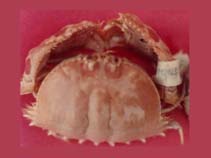Calappa philargius (Linnaeus, 1758)
Spectacled box crabWarning: DOMDocument::load(): SSL operation failed with code 1. OpenSSL Error messages: error:140770FC:SSL routines:SSL23_GET_SERVER_HELLO:unknown protocol in C:\Apache24\htdocs\includes\SpeciesSummary.lib.php on line 1236
Warning: DOMDocument::load(): Failed to enable crypto in C:\Apache24\htdocs\includes\SpeciesSummary.lib.php on line 1236
Warning: DOMDocument::load(https://sealifebase.nrm.se/webservice/AquaMaps/getAMap.php?genus=Calappa&species=philargius): failed to open stream: operation failed in C:\Apache24\htdocs\includes\SpeciesSummary.lib.php on line 1236
Warning: DOMDocument::load(): I/O warning : failed to load external entity "https://sealifebase.nrm.se/webservice/AquaMaps/getAMap.php?genus=Calappa&species=philargius" in C:\Apache24\htdocs\includes\SpeciesSummary.lib.php on line 1236
Classification / Names Common names | Synonyms | CoL | ITIS | WoRMS
| Decapoda | Calappidae
Environment: milieu / climate zone / depth range / distribution range Ecologie
; diepteverspreiding 0 - 100 m (Ref. 343). Tropical
Verspreiding Landen | FAO regio's | Ecosystems | Voorkomen | Introducties
Indo-Pacific.
Length at first maturity / Size / Gewicht / Leeftijd
Maturity: Lm ? range ? - ? cm Max length : 12.0 cm CW mannelijk/geslacht niet bekend; (Ref. 343)
Korte beschrijving Morfologie
The two thick and strong chelipeds are similar in size. The movable fingers differ in forms and functions. Body is brownish-red, with distinct dark red spots on the chelae. A dark red ring is present around the eyes. Anterolateral margin of the carapace granulated. Posterolateral and posterior margins bear around 15 shape teeth.
Minimum depth from Ref. 99823. Subtidal (Ref. 106854). Occurs in sandy to slightly muddy substrates. Subtropical and tropical climates (Ref. 343). During the day, it buries itself, leaving only the eyes above the substratum. Forages as night. Feeds mainy on molluscs (Ref. 125532).
Life cycle and mating behavior Geslachtsrijpheid | Voortplanting | Kuitschieten | Eieren | Fecundity | Larven
Members of the order Decapoda are mostly gonochoric. Mating behavior: Precopulatory courtship ritual is common (through olfactory and tactile cues); usually indirect sperm transfer.
Voornaamste referentie
Referenties | Coördinator | Medewerkers
Ng, P.K.L. 1998. (Ref. 343)
Status op de Rode Lijst van het IUCN (Ref. 130435)
Status bij CITES (Ref. 108899)
Not Evaluated
CMS (Ref. 116361)
Not Evaluated
Gevaarlijk voor mensen
Harmless
Gebruik door de mens
| FishSource |
Tools
Meer informatie
Populaire namen
Synoniemen
Predators
Voortplanting
Geslachtsrijpheid
Kuitschieten
Fecundity
Eieren
Ontwikkeling van de eieren
Synoniemen
Predators
Voortplanting
Geslachtsrijpheid
Kuitschieten
Fecundity
Eieren
Ontwikkeling van de eieren
Internet-bronnen
BHL | BOLD Systems | CISTI | DiscoverLife | FAO(Publication : search) | Fishipedia | GenBank (genoom, nucleotide) | GloBI | Gomexsi | Google Books | Google Scholar | Google | PubMed | Tree of Life | Wikipedia (ga naar, zoek) | Zoological Record
Estimates based on models
Preferred temperature
(Ref. 115969): 22.3 - 29.1, mean 28 (based on 1902 cells).
Prijsklasse
(Ref. 80766):
Unknown.



